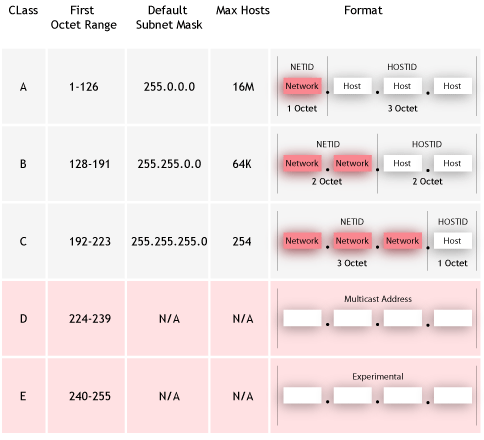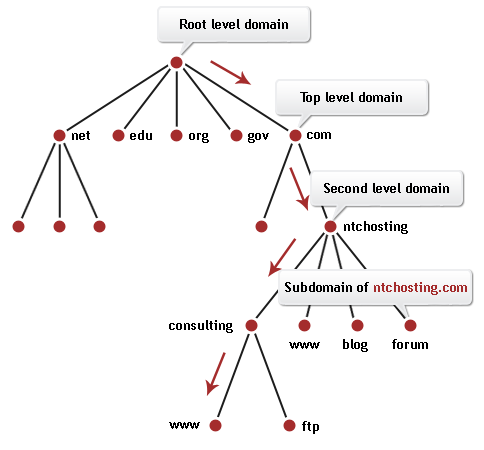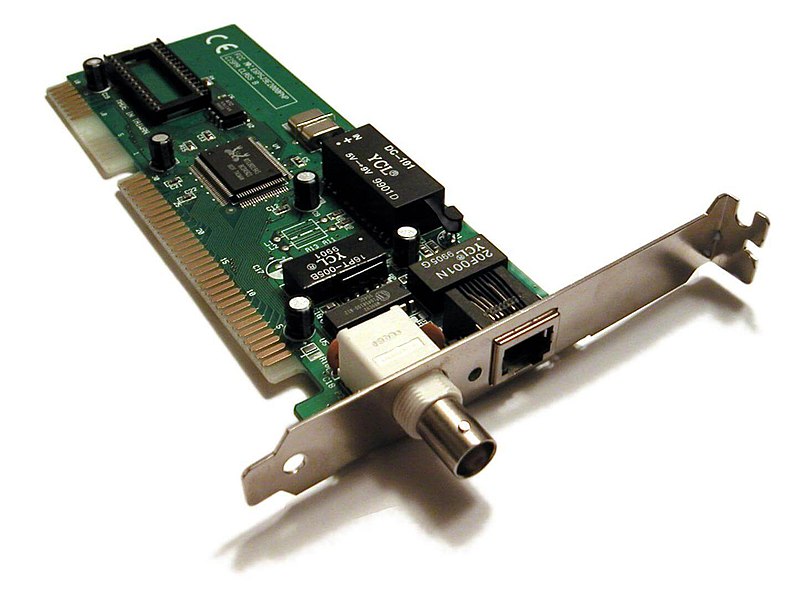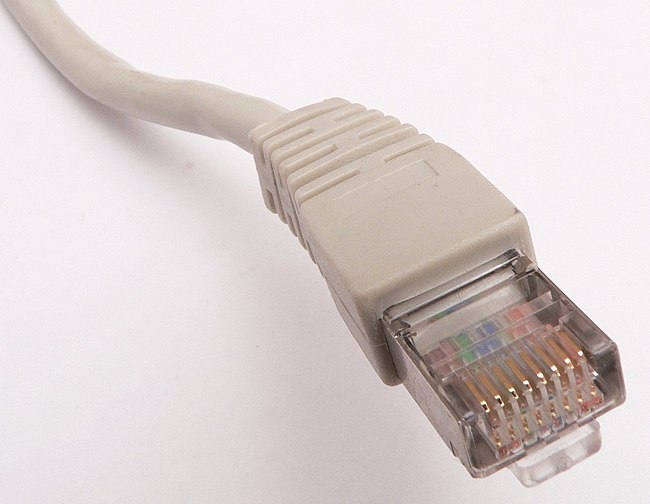The Internet: Computer Network Hierarchy
Every computer that is connected to the Internet is part of a network. For example, you may use a modem to connect to an Internet Service Provider(ISP). When you connect to your ISP, you become part of their network. The ISP may then connect to a larger network and become part of their network. The Internet is simply a network of networks. DNS is an Internet service that translates domain names/hostnames to IP addresses and IP addresses to their associated domain names/host names. DNS helping each visitor refer to the desired website only by typing its alpha-numeric name (domain name) in the browser instead of its real numeric system name (IP address).
Internet Protocol: IP Addresses
A typical IP address might be 216.27.22.162. Every machine on the Internet has a unique identifying number, called an IP Address. The IP stands for Internet Protocol, which is the language that computers use to communicate over the Internet. A typical IP address is make it easier for us humans to remember, IP addresses are normally expressed in decimal format. The four numbers in an IP address are called octets, because they each have eight positions when viewed in binary form. If you add all the positions together, you get 32, which is why IP addresses are considered 32-bit numbers.
The octets serve a purpose other than simply separating the numbers. They are used to create classes of IP addresses that can be assigned to a particular business, government or other entity based on size and need. The octets are split into two sections: Network and Host. The Network section always contains the first octet. It is used to identify the network that a computer belongs to. Host sometimes referred to as Node is identifies the actual computer on the network. The Host section always contains the last octet.
IP address structure and classification
Class A
Class A addresses are assigned to networks with a very large number of hosts. The high-order bit in a class A address is always set to 0. The next seven bits (completing the first octet) complete the network ID. The remaining 24 bits (the last three octets) represent the host ID. This allows for 126 networks and 16,777,214 hosts per network.
Class B
Class B addresses are assigned to medium-sized to large-sized networks. The two high-order bits in a class B address are always set to binary 1 0. The next 14 bits (completing the first two octets) complete the network ID. The remaining 16 bits (last two octets) represent the host ID. This allows for 16,384 networks and 65,534 hosts per network.
Class A addresses are assigned to networks with a very large number of hosts. The high-order bit in a class A address is always set to 0. The next seven bits (completing the first octet) complete the network ID. The remaining 24 bits (the last three octets) represent the host ID. This allows for 126 networks and 16,777,214 hosts per network.
Class B
Class B addresses are assigned to medium-sized to large-sized networks. The two high-order bits in a class B address are always set to binary 1 0. The next 14 bits (completing the first two octets) complete the network ID. The remaining 16 bits (last two octets) represent the host ID. This allows for 16,384 networks and 65,534 hosts per network.

Class C addresses are used for small networks. The three high-order bits in a class C address are set to binary 1 1 0. The next 21 bits (completing the first three octets) complete the network ID. The remaining 8 bits (last octet) represent the host ID. This allows for 2,097,152 networks and 254 hosts per network.

Class D
Class D addresses are reserved for IP multicast addresses. The four high-order bits in a class D address are always set to binary 1 1 1 0. The remaining bits are for the address that interested hosts recognize. Microsoft supports class D addresses for applications to multicast data to multicast-capable hosts on an internetwork.
Class E
Class E is an experimental address that is reserved for future use. The high-order bits in a class E address are set to 1111.
The
network ID cannot begin with the number 127. The number 127 in a class A
address is reserved for internal loopback functions. For example, 127.0.0.1 is the common loopback address.
·
Loopback
means the interface created and designated to test a local port or interface.
It routes test messages from their source device back to the source without any
processing or modification.
·
The loopback IP address is the
address used to access itself. A loopback interface is also known as a virtual
IP, which does not associate with hardware interface.
·
The loopback address is used to test
network software without physically installing a Network Interface Card (NIC), and without having to
physically connect the machine to a TCP/IP network.
Internet Protocol: Domain Name System
Although people can type address information like http://207.241.148.80/ into their Web browser to visit sites, being able to use proper names like http://www.hotmail.com/ is much more practical. When someone types a site's name into their browser, DNS looks up the corresponding IP address for that site, the data required to make the desired network connections between Web browsers and Web servers.
The DNS organizes its servers into a hierarchy. For the Internet, so-called root name servers reside at the top of the DNS hierarchy. The Internet root name servers manage DNS server information for the Web's top-level domains (like ".com" and ".uk"). Servers at the next lower level of the DNS hierarchy track second-level domain names and addresses (like "hotmail.com").
Hierarchy of domain names
ISP
Short for Internet Service Provider, it refers to a computer access to the Internet. The service provider usually provides a software package,username and password. You can then log on to the Internet and browse the World Wide Web and send and receive e-mail. ISPs also serve large companies, providing a direct connection from the company's networks to the Internet. ISPs.
An ISP is a company that provides individuals and other companies access to the Internet and other related services such as Web site building and virtual hosting. An ISP has the equipment and the telecommunication line access required to have a point-of-presence on the Internet for the geographic area served. The larger ISPs have their own high-speed leased lines so that they are less dependent on the telecommunication providers and can provide better service to their customers.
HTTP (Hypertext Transfer Protocol)
HTTP stands for Hypertext Transfer Protocol. It is an TCP/IP based communication protocol which is used to deliver virtually all files and other data, collectively called resources, on the World Wide Web. These resources could be HTML files, image files, query results, or anything else.Every Web server on the Internet conforms to the hypertext transfer protocol (HTTP). The Hypertext Transfer Protocol (HTTP) is an application-level TCP/IP based protocol with the lightness and speed necessary for distributed, collaborative, hypermedia information systems (internet).
There are three important things about HTTP of which you should be aware:
The diagram shows where HTTP Protocol fits in communication:

There are three important things about HTTP of which you should be aware:
·
HTTP
is connectionless: After a request is made, the client disconnects from the
server and waits for a response. The server must re-establish the connection
after it process the request.
·
HTTP
is media independent: Any type of data can be sent by HTTP as long as both the
client and server know how to handle the data content. How content is handled
is determined by the MIME specification.
·
HTTP
is stateless: This is a direct result of HTTP's being connectionless. The
server and client are aware of each other only during a request. Afterwards,
each forgets the other. For this reason neither the client nor the browser can
retain information between different request across the web pages.
The diagram shows where HTTP Protocol fits in communication:









 Fig. 4. BNC connector
Fig. 4. BNC connector





























